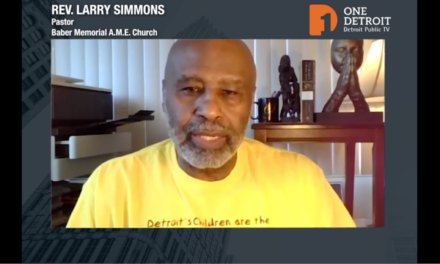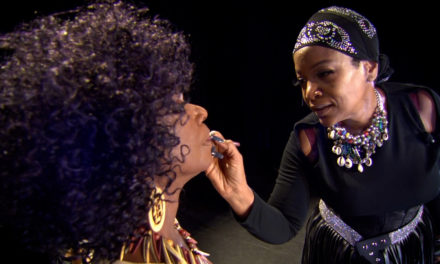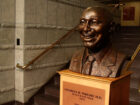Acclaimed hockey coach, Scotty Bowman, reflects on one of his most defining moments of his time on the ice. In his first interview since the premiere of The Russian Five – and before its debut on PBS – Coach Bowman reflects back on the legacy and foundation he helped build in Detroit, and what he says he learned from being a part of this incredible moment in sports history. Watch on Detroit Public TV Channel WTVS 56.1 on December 17 at 9pm ET.
Read the full transcript
Fred Nahhat As we celebrate the broadcast premiere of the Russian Five film on your PBS station, a perfect time to bring in the coach, Scotty Bowman, for a great conversation about hockey and this event. Twenty-five years ago, the Russian Five first went on the ice coach, time flies.
Scotty Bowman, Former Head Coach, Detroit Red Wings It sure does, and, you know, when I got to Detroit, of course, we had Vladimir Konstantinov and Sergei Fedorov with Vyacheslav Kozlov had just started he came over from Russia. Started in the minors, but didn’t stay very long and had a great first year. And then we were looking for a defenseman, actually, the trade deadline. And we were looking for depth to be to be truthful about it. And Slava Fetisov was in New Jersey, but he wasn’t playing very much, so we made the deal to get Slava and we had a good run that year, but we got beat in the finals four straight by his old team New Jersey. And he had kept mentioning to me during that time my good friend Igor Larionov, we knew him because he single handedly just about beat us with San Jose in the playoffs in 94. So, he said, you know, he’d like to come to Detroit, and I said, well, I don’t think that they’ll ever trade him. But we had a surplus of winger’s, and I was able to make the trade to get Igor. We traded a good player, Ray Sheppard, who is a good goal scorer, but we had other right wingers, Dino Ciccarelli, Marty Lapointe was coming along. So, it made a lot of sense, and we got Igor in there. And then about maybe a month into the season, they were, we haven’t even practice with them. And we started to practice them, and they look different. Use them in Calgary one night, just a few weeks ago, it was the anniversary of that time and they had the puck the whole game. And it’s amazing when they were on the ice, we won the game three to nothing. And then that started it, and I was careful, I didn’t know, you know, if other teams would try to try to defend them. They were pretty hard to defend them because people had never seen them play, and neither had the players in the NHL. So, it was it was a unique time for us and gave us a dimension that other teams didn’t have and that resulted in those first two Back-To-Back cups.
Fred Nahhat And of course, it was a unique style of play. On surfaces, you know, finesse style It seems to be a little higher order of finesse than the game that we are used to, but it’s really built on discipline and what happens in the neutral zone. Talk about the neutral zone, because that to me and a lot of hockey fans and amateur coaches is something that we’re always trying to get some success with.
Scotty Bowman, Former Head Coach, Detroit Red Wings Well, it’s odd that we do this ZOOM call, just two hours ago, I had a call from Igor Larionov and it was a twofold call. He’s turning 60 on December the 2nd and it’s home, he’s living in Moscow. He’s coaching the US, uh the Russian junior team going to play in the world championships up in Edmonton in December? So, he got talking and he went he took his junior team to a Finnish tournament. It’s called the Kerala Cup, and the other team, Sweden and Czech Republic and Finland, use their top team, their senior team, but Russia, the Russian senior players were playing in the KHL. So, they snuck in there with the junior team to get some work done before the world championship. Well, what you know it? They won; they won the tournament. They have an excellent young goalie that drafted this year by Nashville. So, Igor was talking to me and he said I said, how are you liking your coaching? You know, I always thought he could be a good coach, and he’s such a unique guy. And he said, well, it was a little different, I stressed puck possession. And he said, you know, the players, a few of them I mean a half a dozen are playing in the KHL at a young age. And he said, you know, in the KHL they want to make that long pass up to the far blue line and the guy tips the puck in and then they just wait till the other team comes back. And he said, I have a hard time with it because I want puck possession. And, you know, that’s another story with Igor, he left us to go to the Florida Panthers and he stayed about half a season, but they wanted to shoot the puck in, and he rebelled against that style. And then all of a sudden that was in the 2001 season and we brought him back. And would you it, we want another cup with that system. But he stressed puck possession, he’s got a young team in Russia now. He did the same thing with us; he was kind of they called him the professor and of course he had Slava had been a member of the five men unit previously in Russia. So, the idea was that you didn’t have to chase the puck, you kept the puck, somebody would be open. Players kept moving in the neutral zone rotating around and all of a sudden when I first looked at it and they were starting to practice it. And then all of a sudden, you’d see the guy that seemed to get the breakaways, oddly enough, was Konstantinov. He came from the right defense slot and he’d be coming up the ice, and I get to the other blue line, he gets a pass and he’s got a breakaway. So, it’s odd that we’re twenty-five years later and Igor Larionov is still coaching and he’s still stressing puck possession. And I think it’s spilled over on the rest of our North American players that we were able to keep the puck a lot. And it makes sense if you have the puck, your defensive vulnerability’s not very, much because the other team has to get it off you. So, I’ve always, I mean, that really taught me a big lesson. I mean, I had good teams in Montreal, and we had a good puck possession, but the Russian five reinforced it with us in Detroit from the late 90s into 2002.
Fred Nahhat Well, I think what we all appreciated was seeing the Russian Five integrating with something literally called the grind line and making those two styles of those systems complement one another. I guess that was by design.
Scotty Bowman, Former Head Coach, Detroit Red Wings Well, you know, when you think about it, when you have four lines and two or three of them play different styles, it makes it tough to defend on the other team because you’re not playing the same thing all the time. So, all of a sudden, you’re right, the grind line was, they stressed for checking. They stressed the physicality, they could defend, and then they turned around and then the Russian Five would come out and they would play offense. So, it really threw a good monkey wrench into the other teams. It wasn’t always that way, but they did a good job of making sure that it was tough to play against.
Fred Nahhat And it seems, at least from a fan’s perspective, you’re always a coach that stressed a system over star players, and then you had to get people to change their game and let the star shine when they could shine, but also be a part of a greater system for success.
Scotty Bowman, Former Head Coach, Detroit Red Wings You’re right, and you know, the mixture of the team and I like the fact that we had the size. And I think to win in the league, and it’s no different now, if you can’t play physical at times or you can’t play puck possession, or you can’t play defense. And I was always one that could stress defense, because no matter how you going to do it and how are you going to win, you’ve got to get a lead, you’ve got to score and then you’ve got to defend that lead. And the good players can play that way. We were fortunate in Detroit, of course, Steve Yzerman became, I think the top two player in the league, gave up a lot of his offense to play defense. Nick Lidstrom would be a good example when you look at his stats. Nick was premier defenseman for a decade at least, and one I those as Norris trophies well deserved. But he could play offense and defense and they just had that sixth sense about them. What is it? They know how, they call it hockey IQ, but it’s having like a sixth sense. They know where the players are around them, they don’t give the puck away, they know it’s hard to get back, so that was a big part of the Red Wing style. And the other teams have picked it up, and the good teams that’s, the Lightning just won this year. And of course, Steve was instrumental in building that team, but they showed what they could do. They got good skilled players and skilled players can win games if they play the right way.
Fred Nahhat And the throwing the puck to open ice by design and having a guy meet the puck where it lands seem to be something that maybe the Russian Five maybe model a little bit for the other players, because at least from a fan’s perspective, it seemed like they picked up a little bit of that finesse from the Russian five players.
Scotty Bowman, Former Head Coach, Detroit Red Wings Well, the Russians started to play a different style when they learned the game and the summit series, they call it the seventy-two series Team Canada against Team Russia winning games before it was over. Canada finally won late in the eighth game, but we didn’t see that kind of style in North America because all of a sudden, their defensemen would always pass it to each other in the defensive zone. The two forwards would take off and leave the zone, which was, that was a no in our game. They would leave the zone, they crisscross in the neutral zone, and automatically when we saw that for the first time, it pulled our defensemen in North America out of the end zone and left them, because they didn’t want these players to get breakaways. And when you think about it, that was when there was a red line in the center line was sort of like a protector for the defensive team. Now, of course, you can go all the way up to the far blue line without the center line. So that was the amazing part of the Russian style that we had a tough time in that series. And it was supposed to be a one-sided series, but it was not one sided, as we never see that style. And I think it’s like all sports, when you see a style for the first time, whatever sport you’re playing, I mean, people get on to it and they’ll eventually be able to defend it. But the guy that starts it, the team that starts it, it’s got a big edge, and they brought that to the NHL. They crisscrossed wingers when I first started in this league, if you’re a right winger, you had one third in the ice and you stayed there. And if you’re a left winger, you had the far side and if you’re in the middle you’re the center. And very few players used to cross from one zone to another, like from one side to another. And now it’s integrated into the NHL. It looks a little helter skelter for me now, you know, growing up with it, a more standard style. You have to live with the present and that I enjoy trying to change and look at what we see now. And the players are so fast and it’s such a different game, but the Russians did change a lot of the thinking for North America. You know, a team’s back and started in the 70s and it progressed. And I would say Edmonton Oilers in the 80s took advantage of skilled offensive players that could outscore you. And they won I think they won five cups in seven years or something.
Fred Nahhat Yeah, it’s remarkable the people teams learn to defend a new system, but then they, of course, begin to emulate it. Appreciate you taking the time with us. We talked about the professor; I just want to talk about each of the players individually. Real quick, when you walked into the team, 93, 94, Sergei Fedorov was a MVP and really a dominant force. How was it working with Sergei Fedorov from the beginning?
Scotty Bowman, Former Head Coach, Detroit Red Wings He was a unique Russian player and that he first came into Detroit the year before I was there, he was a solid defensive player. He could play defense. His offense wasn’t there yet, but you could see it was going to be, he had a core. He was a strong he was a lot bigger and stronger than, if you saw him. I mean, he was over he was about nearly 200 pounds. He had legs like tree trunks, and he could play offense and defense. That’s one thing he could do. We move him back on defense for about 6 weeks, he looked like an all-star. And he was a unique player because he was equally proficient offensively and defensively.
Fred Nahhat Definitely a load and Koslov also a lot of, a lot of promise with that prospect, I guess, but really, he took to that style and he flourished within the Red Wing system.
Scotty Bowman, Former Head Coach, Detroit Red Wings Kozlov and Fedorov played most of their career together. We brought Slava, there’s probably about a 3-year difference in age, but Slava could put the puck in the net. His first year in Detroit he scored 34 goals as a rookie. I think you flew under the radar really. And, you know, he was such an important part of our offense when I first got there. And, you know, he just could he knew where to go in the in the offensive zone. And Sergei was a great passer, so there was a great combination. And, you know, and then Vladimir Konstantinov was just such a, I mean, he would have been challenging, he probably would have been challenging Nick Lidstrom for a lot of, you know, the Norris Trophy for the best defenseman. Because he had a unique style of players, he took no prisoners. He was aggressive, probably one of the more aggressive Russian players in history. And a tragic accident, as everyone knows, but, you know, we all remember how great a player he was.
Fred Nahhat Well, and finally, of course, when you got Slava Fetisov, you got depth, but you also got a hockey mind, a leader and depth in the sense of what he’s doing today just shows his experience and his tendency to be helpful to the younger players, I guess?
Scotty Bowman, Former Head Coach, Detroit Red Wings Yeah, he worked as a minister of sport for a couple of years, and now he’s working on academies like he there. I like the idea of what they do over there. I mean, they have a big advantage, you know, Russia, there’s no NFL football, there’s no basketball or baseball. So, they’re getting top athletes to play hockey and they’re pouring a lot of money, it’s a big country. And the kids, they don’t stress, the early going, and I know I talked to Igor again this morning. They stress fundamentals, they don’t use score clocks for really young kids, they want you to learn how to skate, and pass and shoot. And then, you know, that’s what they that’s their style, and maybe we could maybe we could think about that. You know, I mean, I’ve got some grandkids that are just starting in sports and so much stress on winning, you know. And I had a quick just a quick story, I have a grandson plays flag football in Boston. My daughter’s son and they lost the championship game. And, you know, they got they came second, and they lost the game. And they got their, the winning team got trophies and he got a ring. And, you know, he was so upset, he was not, I mean, you know, I had to sort of tell my daughter, I said, look, they had a great season. They didn’t win, they came second, but, you know, but we stress winning a lot. And, you know, at a young age, because I don’t know, you know, as people grow up and finish school and finish college or whatever they do and get into business, get a job, we compete long enough in our lives. You know, if I start competing at six and seven, you know, nothing wrong with that, I guess you learn it’s just a philosophy I have. I would like to see us in sports in the early going, teach us how to play what maybe not as much stress on a winner and a loser. I mean, I know it’s got to come eventually, but push it back a little bit.
Fred Nahhat Well, yeah, it’s one great thing that USA Hockey does, and their coaching certification training is the very first day level one. They show you what chance you have, less than a tenth of a percent of all youth hockey players just in North America of getting to the NHL. So just reinforcing that with.
Scotty Bowman, Former Head Coach, Detroit Red Wings Make it fun, yeah.
Fred Nahhat Yeah, all right. Well, listen, we’re so grateful that you took some time to share with us. We’re celebrating the 25th anniversary of the time they first went on the ice, but also this remarkable film, the Russian Five, premiering on PBS, your PBS station coach Scotty Bowman, our great thanks for sharing some time with us.
Scotty Bowman, Former Head Coach, Detroit Red Wings Thank you, and my best wishes; it’s a great film. Thank you.









